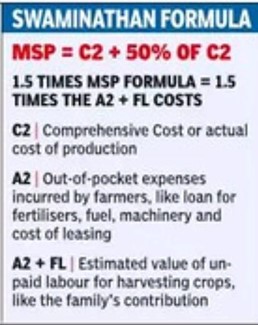-
23 Feb 2024
GS Paper 3
Economy
Day 83: Discuss the rationale behind the Swaminathan Commission's recommendation of the C2+ 50% formula for determining MSP. (250 Words)
- Write an introduction about the Swaminathan Commission and its formula.
- Discuss its component which is useful in the determination of the MSP.
- Write a conclusion.
Introduction
The Swaminathan Commission, officially known as the National Commission on Farmers, was constituted in 2004 with the aim of addressing the various issues faced by farmers in India, including agricultural policies, crop pricing, and rural distress. One of the key recommendations made by the Swaminathan Commission was the adoption of the C2+50% formula for determining the Minimum Support Price (MSP) for crops.
Body
The C2+50% formula:
C2 is the actual cost of production, including account rent and interest foregone on land and machinery owned by farmers. According to the commission, the formula to calculate MSP would be MSP= C2+ 50% of C2. The commission recommended that the MSP should be 1.5 times the farmers’ input costs.
The rationale for the formula:
- Cost recovery and profit: The C2 component includes all paid-out expenses plus an imputed value for unpaid factors like family labour and rent on owned land (C2). The 50% markup on C2 aims to ensure farmers recover their full cost of production and earn a reasonable profit margin.
- Promoting investment and efficiency: By guaranteeing a minimum return above costs, the formula encourages farmers to invest in better inputs, technology, and practices, potentially raising productivity and farm incomes over time.
- Fairness and reducing income disparity: The formula aims to address the historical issue of farmers often receiving prices below their production costs, leading to financial distress and income disparity compared to other sectors.
- Implementing the C2+50% formula would not only ensure fair remuneration but also contribute to the overall well-being of farming communities. It aligns with the goal of achieving livelihood security for farmers, especially during challenging times.
Arguments in favor:
- Farmers' organizations see the formula as a way to ensure fair compensation for their efforts and provide a safety net against market fluctuations.
- Some economists argue that higher and predictable MSPs can incentivize increased agricultural production, contributing to food security.
- Implementing the formula could potentially uplift rural incomes and reduce poverty, contributing to overall economic development.
Arguments against:
- Critics argue that the formula is too rigid and doesn't account for market dynamics, potentially leading to inefficiencies and surpluses.
- High MSPs could put pressure on government finances and distort market signals, discouraging private investment in agriculture.
- Concerns exist about the feasibility of implementing the formula for all crops due to budgetary constraints and administrative challenges.
Conclusion
However, the government has not fully adopted the C2+ 50% formula, but has increased MSPs for some crops in recent years, and farmers continue to demand legal status for MSP based on the C2+ 50% formula. The decision on its adoption requires careful consideration of its potential economic, social, and political implications.





